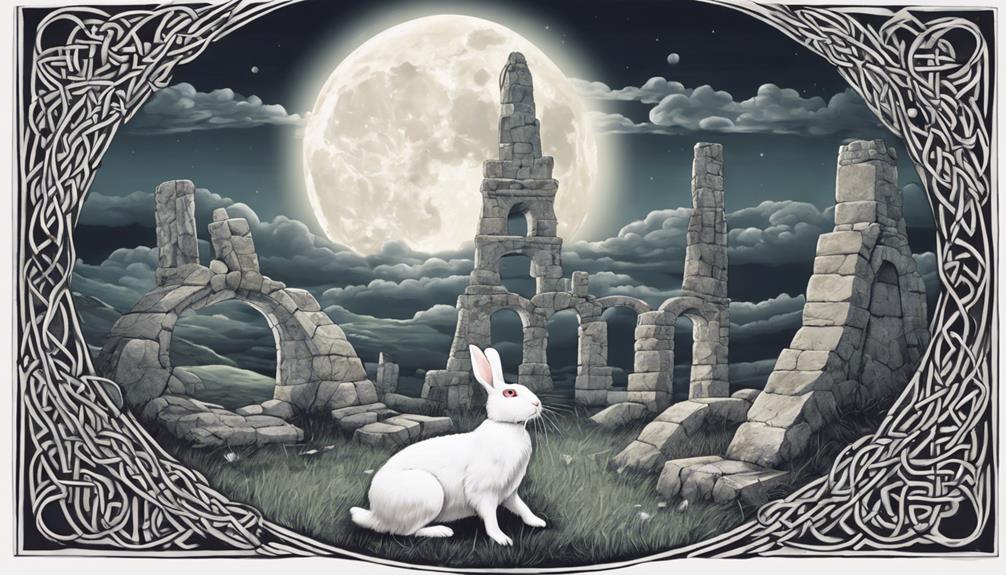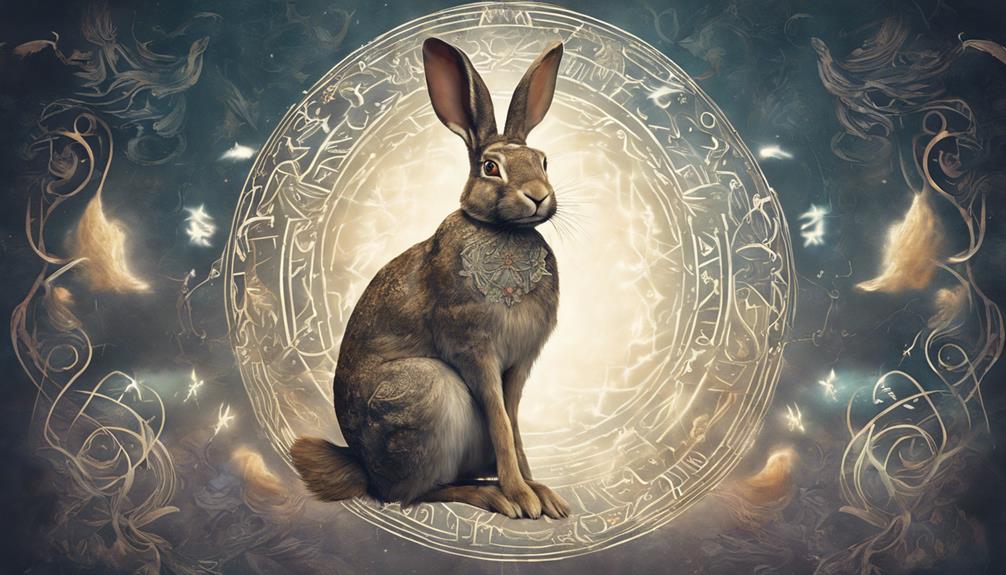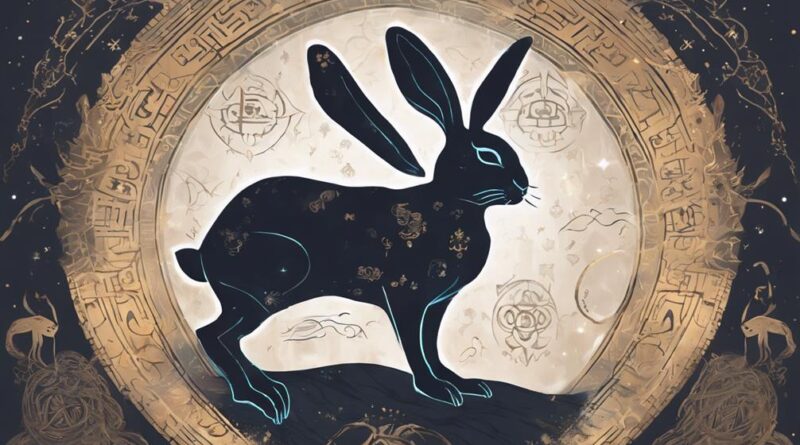10 Best Rabbit Myths and Legends Unveiled
Uncover intriguing rabbit myths and legends that transcend time and culture, revealing mystical symbolism and profound meanings. From the clever Trickster Rabbit to the Lunar connections in diverse mythologies, these tales illuminate themes of sacrifice, fertility, and wisdom passed through generations. Explore the Rabbit's role in luck, rebirth, and guiding principles across various societies, including its symbolic significance in astrology and ancient Celtic beliefs. Discover how the Rabbit embodies agility, wit, and divine communication, offering insight into humanity's quest for knowledge. Each tale unravels a rich tapestry of stories reflecting on the enduring legacy of these beloved creatures.
Origins of the Moon Rabbit
The origins of the Moon Rabbit can be traced back to ancient folklore and mythology, where it's often depicted as a mystical creature inhabiting the celestial realm. This symbolism of the Moon Rabbit is deeply rooted in various cultures worldwide, each with its unique interpretations and connections to the lunar cycle.
Across different cultural variations, the Moon Rabbit holds significance as a symbol of sacrifice, fertility, and even immortality. In East Asian folklore, particularly in Chinese and Japanese traditions, the rabbit is believed to be pounding the elixir of life on the moon, emphasizing themes of longevity and rejuvenation. Conversely, in Native American legends, the rabbit is seen as a trickster figure, using its cunning nature to outwit adversaries and teach moral lessons.
The lunar connections of the Moon Rabbit are prevalent in many mythologies. In Aztec culture, the rabbit is associated with the moon goddess, who represents fertility and nourishment. Similarly, in Egyptian mythology, the rabbit symbolizes the cycle of birth, life, death, and rebirth, mirroring the phases of the moon.
Trickster Rabbit in Folklore
Among the various archetypal figures found in folklore across cultures, the trickster rabbit stands out for its cunning and clever nature, often portrayed as a mischievous yet resourceful character in tales and legends. Rabbit folklore has deep roots in storytelling traditions worldwide, with the trickster rabbit playing a significant role in shaping cultural narratives.
Here are some key points to consider when exploring the trickster rabbit in folklore:
- Trickster tales: Trickster tales featuring rabbits can be found in numerous cultures, showcasing the rabbit's ability to outwit larger or more powerful adversaries through cleverness and quick thinking. These tales often serve as cautionary stories or as a way to explain natural phenomena.
- Cultural significance: The trickster rabbit embodies traits that are valued in different cultures, such as intelligence, adaptability, and the ability to thrive in challenging situations. By embodying these characteristics, the trickster rabbit becomes a relatable and enduring figure in folklore.
- Role in storytelling traditions: The trickster rabbit often serves as a central character in oral traditions, fables, and myths, passing down cultural wisdom and values through generations. Its antics and adventures entertain audiences while imparting moral lessons and societal norms.
- Symbolism and representation: In some cultures, the trickster rabbit symbolizes fertility, abundance, or the cycle of life and death. Its portrayal reflects the interconnectedness of nature and human existence, adding depth to the cultural meanings associated with rabbits in folklore.
Rabbit in the Chinese Zodiac
Rooted in ancient Chinese astrology, the Rabbit in the Chinese Zodiac holds symbolic significance and personality traits that influence individuals born under this sign. In the Chinese zodiac, the Rabbit is the fourth animal in the twelve-year cycle and is associated with the lunar calendar. People born in the Year of the Rabbit are believed to be gentle, quiet, elegant, and kind-hearted. They're often considered lucky, with a talent for cultivating harmonious relationships with those around them.
The Rabbit's connection to the moon in Chinese astrology adds layers to its interpretation. The moon symbolizes femininity, intuition, and the subconscious mind. This association infuses those born under the Rabbit sign with qualities like sensitivity, creativity, and empathy. They're thought to possess a heightened awareness of their surroundings and a deep understanding of emotions.
Individuals born under the Rabbit sign are believed to be diplomatic and tactful, able to navigate social situations with grace and finesse. They're also known for their artistic talents and appreciation of beauty. However, they may sometimes come across as reserved or even aloof due to their introspective nature. Overall, the Rabbit in the Chinese Zodiac embodies traits that reflect a harmonious and refined personality, making those born under this sign cherished for their gentle and compassionate demeanor.
Rabbit as a Symbol of Fertility
In ancient folklore and cultural beliefs, rabbits have long been revered as symbols of fertility and abundance. The idea of the rabbit as a representation of fertility can be seen across various cultures and artistic expressions throughout history.
Here are some key points regarding the rabbit's symbolism in art and its role as a totem animal:
- Rabbit Symbolism in Art: Artists often depict rabbits in paintings, sculptures, and other art forms to symbolize fertility, growth, and new life. The rabbit's prolific nature and ability to reproduce quickly make it a potent symbol of fertility in artistic representations.
- Rabbit as a Totem Animal: In many cultures, the rabbit is considered a totem animal, embodying traits like creativity, intuition, and fertility. As a totem animal, the rabbit is believed to bring abundance and prosperity to those who identify with its characteristics.
- Cultural Significance: The rabbit's association with fertility is deeply rooted in cultural practices and beliefs. From ancient civilizations to modern societies, the rabbit continues to be a powerful symbol of fecundity and renewal.
- Mythological Connections: In mythologies worldwide, the rabbit often appears as a symbol of fertility and vitality. Its presence in myths and legends underscores its significance as a potent symbol of life, growth, and regeneration in various cultural narratives.
Rabbit in Native American Mythology
Native American mythology portrays the rabbit as a cunning and resourceful creature intertwined with tales of creation and trickery. In Native American rabbit stories, these creatures often play significant roles in shaping the world and teaching important lessons to humans. Rabbit spirit guides are believed to offer guidance and protection to those who seek their wisdom.
Among the Cherokee people, the rabbit is often depicted as a trickster figure. In stories such as 'Why the Rabbit Has a Short Tail,' the rabbit uses its wit and cleverness to outsmart larger animals. This reflects the Cherokee belief in the power of intelligence and quick thinking.
In other Native American traditions, the rabbit is seen as a symbol of fertility and abundance. The Hopi people, for example, tell stories of the Rabbit Kachina, a deity associated with agriculture and the growth of crops. By embodying the spirit of the rabbit, this Kachina brings prosperity and renewal to the community.
The White Rabbit in Literature
The White Rabbit in literature captivates readers with its enigmatic and whimsical presence, serving as a symbol of curiosity and adventure. This iconic character has been featured in various literary works, each adding unique layers to its symbolism and significance. Here's a closer look at the White Rabbit in literature:
- White Rabbit Symbolism: The White Rabbit often symbolizes the journey into the unknown, the pursuit of knowledge, and the passage of time. Its hurried nature in Lewis Carroll's 'Alice's Adventures in Wonderland' reflects the fleeting nature of time and the urgency to explore the mysteries of life.
- Hidden Meanings: Within the White Rabbit's portrayal lies hidden meanings that invite readers to ponder deeper themes. In some interpretations, the White Rabbit represents the subconscious mind, leading characters into introspective journeys of self-discovery.
- Literary Rabbit Characters: Apart from Lewis Carroll's White Rabbit, other literary rabbit characters have also left a lasting impact on readers. From Beatrix Potter's mischievous Peter Rabbit to Richard Adams' courageous Hazel from 'Watership Down,' these rabbit characters showcase diverse qualities and personalities.
- Iconic Portrayals: The White Rabbit's iconic portrayal as a guide or instigator of adventures has influenced numerous works across different genres. Its presence continues to inspire authors to imbue their stories with elements of wonder, transformation, and the pursuit of truth.
Rabbit in Celtic Mythology

The symbolism and significance of rabbits extend beyond literature, particularly in Celtic mythology where the rabbit holds a prominent and intricate role in various tales and beliefs. In Celtic symbolism, the rabbit is often associated with cunning, fertility, and the moon. This creature is deeply intertwined with the cycles of nature and the spiritual realm in Celtic folklore.
One of the most famous instances of bunny folklore in Celtic mythology is the story of the Welsh goddess, Ceridwen, and her white rabbit. In this tale, the white rabbit symbolizes transformation and rebirth, guiding individuals through the mysteries of life and death. The rabbit's ability to burrow into the earth and emerge into the light mirrors the Celtic belief in the interconnectedness of the physical and spiritual worlds.
Moreover, rabbits are also linked to the Celtic lunar deities, such as the goddess Andraste, who's often depicted with a rabbit by her side. The rabbit's nocturnal habits and affinity for the moon reinforce its association with lunar energies and the cycles of time.
Rabbit Symbolism in Different Cultures
Rabbit symbolism across various cultures exhibits a rich tapestry of meanings and interpretations that reflect deep-rooted beliefs and traditions.
Here are some insights into the cultural interpretations and symbolic meanings attributed to rabbits in different societies:
- Luck and Fertility: In many cultures, rabbits are seen as symbols of luck and fertility. The rapid reproduction rate of rabbits has led to associations with abundance and prosperity in societies like China and parts of Africa.
- Trickery and Cunning: In contrast, some cultures view rabbits as tricksters known for their cunning and cleverness. Native American folklore often portrays rabbits as sly and quick-witted characters who outsmart larger animals.
- Moon Symbolism: Several cultures link rabbits to the moon, drawing connections between the lunar cycles and the Rabbit in the Moon folklore. This association is prevalent in East Asian cultures, where the rabbit is believed to be a companion to the moon goddess.
- Symbol of Rebirth: The rabbit's ability to burrow underground and emerge into the light has led to its symbolism as a creature of rebirth and transformation in various mythologies. This portrayal is prominent in ancient Egyptian and Aztec beliefs, where rabbits symbolize regeneration and new beginnings.
The diverse symbolic meanings and cultural significance attached to rabbits illustrate the deep-rooted connections between folklore, tradition, and societal values.
Rabbit as a Messenger of the Gods

Drawing upon the cultural interpretations and symbolic meanings of rabbits in various societies, the role of the rabbit as a messenger of the gods emerges as a significant theme in mythologies around the world. Rabbits have long been associated with divine communication due to their presence in spiritual tales and folklore. The idea of rabbits serving as a divine messenger holds deep symbolism and spiritual significance in many cultures, signifying a connection between the mortal realm and the divine.
In folklore, the rabbit is often portrayed as an intermediary between humans and gods, delivering messages, omens, or guidance from the spiritual realm. This portrayal highlights the rabbit's perceived qualities such as agility, cleverness, and quickness, which are seen as essential traits for a messenger of the gods. The notion of rabbits as divine messengers isn't limited to a single culture but resonates across various civilizations, showcasing the universal appeal of this symbolic representation.
The spiritual significance of the rabbit as a divine messenger underscores the belief in an interconnected cosmos where animals play a vital role in carrying messages between different realms. This concept enriches the cultural tapestry of myths and legends, emphasizing the enduring fascination with the mystical and the transcendent. The rabbit as a divine messenger stands as a testament to humanity's eternal quest for understanding the mysteries of the universe through storytelling and symbolism.
The Rabbit and the Tortoise Myth
In the famous fable of speed versus perseverance, a well-known animal tale unfolds between a swift mammal and a slow reptile. The Speedy rabbit and the slow tortoise engage in a race that has captivated audiences for centuries. Here are some key points to consider when delving into this classic myth:
- Speedy Rabbit: The rabbit is portrayed as quick and agile, representing traits such as swiftness and confidence. This character is often associated with natural talent and an overconfident attitude.
- Slow Tortoise: On the other hand, the tortoise embodies patience, determination, and persistence. Despite its slow pace, the tortoise symbolizes the importance of steady progress and unwavering focus on the end goal.
- Lesson Learned: The myth of the rabbit and the tortoise teaches us the value of consistency and perseverance. It highlights the significance of staying committed to our objectives, even when faced with challenges or setbacks.
- Unexpected Winner: The ultimate twist in the fable occurs when the slow tortoise surpasses the speedy rabbit to win the race. This unexpected outcome serves as a powerful reminder that success isn't solely determined by speed or talent but by dedication and unwavering effort.
Frequently Asked Questions
Why Do Rabbits Have Such a Strong Association With the Moon in Various Cultures?
Rabbits have a strong association with the moon in various cultures due to the moon symbolism present in many myths and legends.
This lunar connection is often linked to the rabbit's nocturnal behavior, as they're most active during the night when the moon is prominent.
Additionally, the moon's cycles mirror the reproductive cycles of rabbits, further solidifying this connection in folklore and cultural beliefs.
How Did the Rabbit Become a Common Trickster Figure in Folklore?
Trickster tales featuring rabbits have deep cultural origins, with the rabbit often symbolizing cleverness and mischief. Throughout rabbit folklore, the creature's ability to outwit others and navigate challenging situations has led to its portrayal as a common trickster figure.
What Traits or Characteristics Led to the Rabbit Being Chosen for the Chinese Zodiac?
The rabbit was chosen for the Chinese zodiac due to its symbolic traits, such as gentleness, cleverness, and agility, which align with the lunar symbolism associated with the zodiac.
These characteristics are believed to reflect the essence of the rabbit and its place within the zodiac system.
The rabbit's representation in the Chinese zodiac serves to embody qualities that are revered and valued within Chinese culture, adding depth and meaning to its inclusion.
Why Is the Rabbit Often Linked to Fertility and Reproduction Symbolism?
The rabbit symbolism in various cultures often ties back to fertility and reproduction due to its prolific breeding habits and nurturing nature.
Cultural beliefs around the world have linked rabbits with abundance, growth, and new life.
The rabbit's ability to multiply quickly has been associated with the concept of fertility and the cycle of life in many mythologies and traditions.
These connections have solidified the rabbit's role as a symbol of fertility and reproduction in diverse societies.
What Significance Does the Rabbit Hold in Native American Mythologies That Differ From Other Cultures?
In Native American symbolism, the rabbit embodies a unique blend of cultural significance and spiritual beliefs.
Unlike in other cultures, Native American mythologies often depict the rabbit as closely linked to the lunar connection. This association ties the rabbit to cycles of renewal, regeneration, and the mystical powers of the moon.
Through these beliefs, the rabbit holds a revered place in Native American folklore, symbolizing fertility, intuition, and the interconnectedness of all living beings.
Conclusion
In conclusion, the rabbit holds a significant place in mythology and folklore across various cultures. From being seen as a symbol of fertility to a messenger of the gods, the rabbit's presence is prevalent in stories and legends around the world.
By delving into these myths and legends, we gain insight into the cultural significance and symbolism associated with the rabbit, shedding light on the diverse interpretations and meanings attributed to this beloved creature.
